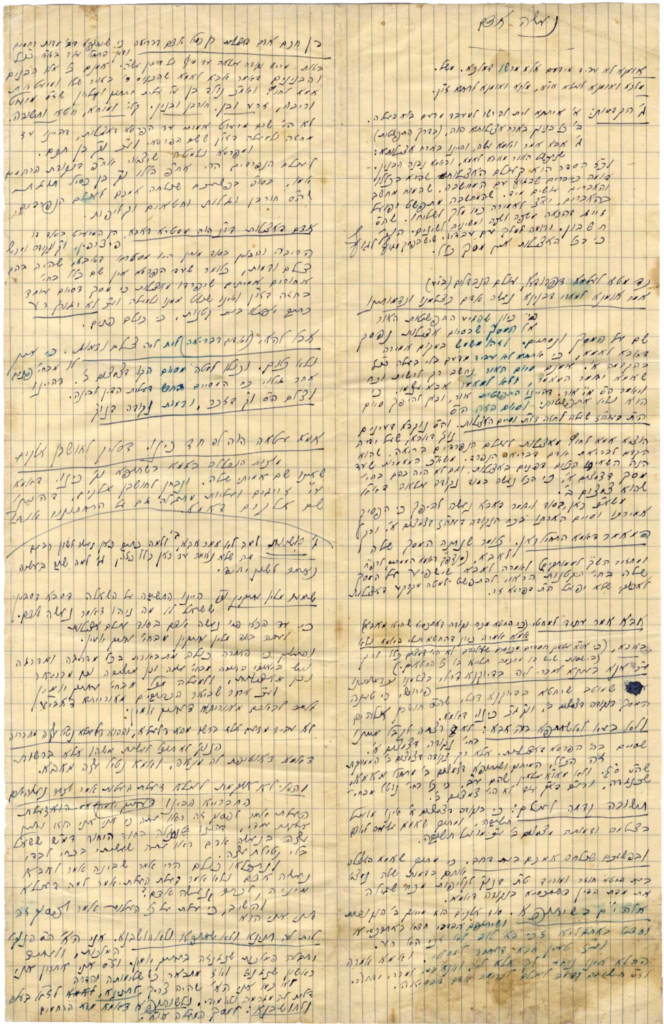
Two volumes with three to four different kabbalistic compositions written by Rabbi Yehudah Leib Ashlag – “Baal Ha Sulam .” Each of these works contains a wealth of kabbalistic material which sheds new light on the author of Sulam ‘s kabbalistic doctrine, and constitute, for the first time, a source to understand his thought sevenfold, in deeper and more significant ways. On most of the pages, the writing is extremely compressed and heavily laden, so that on many pages there are actually three or even four separate columns. The examination that was conducted is only preliminary, and there is undoubtedly the need for much more thorough research, to decipher and extract the scope and depth of the content of the treasure in these compositions, and the manner in which it casts light on the kabbalistic teachings of the Baal Ha Sulam .
General Background:
Rabbi Yehudah Leib Ashlag was born in Likova, Poland in 1884. He immigrated to the Land of Israel in 1922, and passed away in Tel Aviv in 1954. Over the course of dozens of years, he wrote and taught kabbalah in an almost unprecedented manner. The scope and depth of his work made him one of the greatest kabbalists, and one of the most prominent of recent generations. He was the first who made the Zohar accessible to a broad range of scholars, due to his monumental work, Peirush HaSulam (by which he is known). But beyond this, he was the first in recent generations who formulated a comprehensive kabbalistic methodology which made kabbalistic teachings intelligible and even practical among very wide audiences. He saw this as his mission and his purpose; he expressed several times that this was his Heavenly-designated role and mission in the last generation before the redemption, to the extent that he was open about his doctrine as the most real and true step towards the complete redemption.
Indeed, in recent decades, his kabbalistic thought has spread amongst very broad audiences across the world. More and more people, on almost all corners of the earth, find a source of living water in his thought, to quench their soul’s thirst with the lofty ideas, to make his Torah into a living Torah by whose light they walk and from whose waters they frequently drink. This is evident from the communities and classes, the groups and the many, many internet sites which deal with and impart his thought in various ways. This fascinating phenomenon undoubtedly places Rabbi Ashlag as one of the most fascinating and influential Jewish thinkers of recent generations, one who has had an effect dramatically beyond his activity limited to the chareidi-traditional public.
Volume 1: Notebook titled: Divrei Chochmah .
Composition containing kabbalistic ideas and essays, with some of them explained in Rabbi Ashlag’s compositions Talmud Eser Sefirot , Panim Meirot – Panim Masbirot and more. Yet the essays appearing in this work are far more detailed than as they appear in other works. There are even a number of ideas resolved in this work, in a completely different way than they were explained in his other works. This is aside from the completely new material in the Baal Ha Sulam ‘s doctrine. Following are a number (partial) examples of this:
Topics elucidated in Rabbi Ashlag’s kabbalistic thought, titled “Halbashat Elyon LaTachton” (p. 2-3), the essay “Neshikin D’Hevel Dibur” (p. 7) “G’ Eiruvin” (p. 8. Extensive elucidation of this topic, such as does not appear anywhere else in his doctrine). “Matzav HaPartzufin V’Shiur Komah” (p. 17) “Maamar HaSigin” (p. 20. Extensive elucidation of this topic such as appears nowhere else in his doctrine). There is also a comprehensive essay in this work about the harmonious relationship that exists between a person’s body and the various spiritual layers nesting within him, starting from the layer of the soul, up to the higher layers of chayah yechidah. To the best of our knowledge, this essay, in this format, has no peer in Rabbi Ashlag’s kabbalistic doctrine.
What makes this work even more amazing and fascinating is the letter that appears at its conclusion, addressed to his bother, Rabbi Shmuel Ashlag, who lived in Warsaw (“my brother in body and my disciple in soul”). This letter reveals the exceptional connection between Rabbi Ashlag and his brother Rabbi Shmuel for the first time. Until now, the character of the relationship between the two was almost completely unknown, only about two letters between them were published (in Pri Chacham ), which contain very meager material. However, in this letter we are exposed to a very deep connection. Beyond that, we are even made aware of the reason why Rabbi Ashlag did not see fit to keep continuously in contact with his brother in Warsaw, as Rabb Ashlag writes to him:
“And now you will see the truth, why I withhold my hand from writing to you from the day we separated to this day, not [writing] even the smallest of small words, to teach you the path upon which to walk, because you need a connection, and a person cannot be placed under the wings of the Divine Presence via letters and mailings, because it is necessary to connect in truth to the mind and internalness of his rabbi in order to merit returning with the ה of הבראם … (spiritual perfection).”
These words by Rabbi Ashlag are connected to the broad context of the entire letter, that a person experiences a number of births and pregnancies in his life, and the meaning of spiritual fatherhood and brotherhood that exists between people. It can be surmised that this complete work was sent to his brother Rabbi Shmuel in its entirety, with the intent by his brother Rabbi Ashlag being to instruct him and place him in the in the beam of the light of the foundations of his kabbalistic doctrine and the ideas in general. Without a doubt, this is an essay and material regarding the importance and significance of which it is impossible to overstate, both from the aspect of the pure thought of Rabbi Ashlag’s doctrine and from the personal-biographical aspect, about his life and the relationship with his family (who had remained in Poland after Rabbi Ashlag’s immigration to the Land of Israel at the beginning of the 1920s).
Rabbi Ashlag’s brother, Rabbi Shmuel, was killed in the Holocaust, apparently in Treblinka, with his wife and their eight children. This fact gives the material before an us even more chilling significance.
Volume II – 2-3 different completely unknown kabbalistic compositions:
This volume contains a long series of essays, some completely unknown in the Baal HaSulam’s doctrine. From the little we were able to extract from the vast material before us in this volume, we will specify some notable examples:
In this work there is an essay not anything less than revolutionary in Rabbi Ashlag’s doctrine. This essay details no less than 22 aspects of upper netzach, hod, yesod. Yet in Rabbi Ashlag’s doctrine, in its various branches, only three aspects are known.
There are also some very surprising elucidations in this work, about terms that appear in other places in his doctrine, but abbreviated, which were never understood nor deciphered, yet in the works before us, they are actually deciphered and elucidated for the first time! The most notable example of this is the essay discussing ‘האומ”ץ’. These are most enigmatic abbreviations; over many long years, anyone who approached the Baal Ha Sulam ‘s doctrine found very difficult to decipher, such that for the first time, in the merit of these essays, it is possible to merit approaching the secrets of these matters and their inner meanings.
Other topics resolved in these works are: ‘סתימא דאכימן,’ an essay on ‘מקוה”נ’ (two full pages in this context). This is aside from a series of essays dealing with topics connected to the Zohar on the portion of Bereishit, and in a way, very briefly resolved in the composition Peirush HaSulam on the portion of Bereishit.
Furthermore, in these essays, there is a lot of material connected to “Shaar HaKavanot” in Etz Chaim . Here, we are exposed to another wondrous riddle. From what we know, Rabbi Ashlag was hardly known for “Shaar HaKavanot” (his book Beit Shaar HaKavanot , relates partially, and actually for the first time, to the intentions of prayer, but no more than that). And indeed, there are testimonies from various sources that Rabbi Ashlag spoke explicitly about his having written about “Shaar HaKavanot” as well, but he chose to suppress it. It is very possible this is a truly sensational discovery in Rabbi Ashlag’s doctrine, in that for the first time comprehensive material has been revealed dealing with topics in this “Shaar.”
In this volume there area also two somewhat comprehensive articles connected to the foundations of Rabbi Ashlag’s kabbalistic-philosophic doctrine, on the topic ‘the will to receive – the will to influence.’ There is no more basic nor fundamental subject in comprehending his conceptual outlook. The formulations appearing in these essays are different in content from the way in which they appear in various places across Rabbi Aslag’s broad doctrine. Some of the essays, such as “Man is the Center of Creation” and more, appear in the Baal Ha Sulam ‘s work, “Introduction to the Zohar, ” also not without significant differences. This is aside from additional essays entirely undocumented anywhere else, such as “The Secret of Prophecy” and more.
In conclusion: There is no doubt that these works may become a stunning turning point in the understanding of Rabbi Ashlag’s doctrine and kabbalistic ideas, joyous news for all who seek Rabbi Ashlag’s doctrine and thought. All that is mentioned above is nothing more than a brief survey, merely a preliminary glimpse of what is stored in the vast material before us. Very thorough research is certainly required to plumb the depths of the wealth of essays and ideas in these works, to bring maximal revelation and decoding of the conceptual wealth stored in them.
It is important to note and emphasize that acquisition of these writings will grant full and exclusive rights to arrange and publish these works, and to thereby provide the tens of thousands of disciples of Rabbi Ashlag’s thought with rare and wondrous philosophical achievement.
Number of leaves: 118. Condition of leaves: Very fine (except for a few leaves which were slightly repaired). The leaves are bound in two magnificent leather bindings.
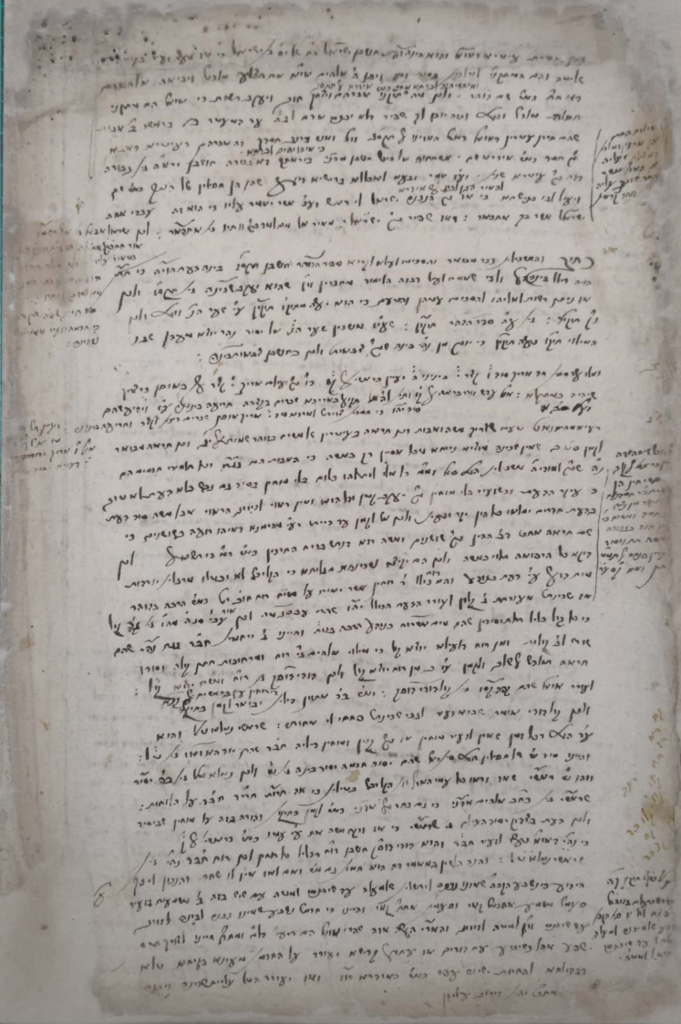
This manuscript has never been printed before. It is an abridged version of his lengthy Chemdat Tzvi , with dozens of comments and supplements. 17-18th century.
Rabbi Naftali Katz, rabbi of Frankfurt am Main and author of Semichat Chachamim termed the author a “G-dly kabbalist, leading preacher …”
Chemdat Tzvi was the first printed elucidation on Tikkunei HaZohar , Amsterdam, 1706. It is a very lengthy, extremely detailed work which indicates astonishing expertise and profound understanding of the Zohar, the writings of the Ari and his disciples. All the prominent Torah leaders of the country extolled the work. In addition to his understanding of kabbalah, he was famed for his profound public speaking skills to the extent that the rabbi of Krakow testified that, “His mouth testifies for him everywhere that he walks, his words are heard in the public gates, because they are sweet.” Rabbi Yissacher Ber, rabbi of Ansbach also wrote extensive praises about him.
In his preface to his commentary, Rabbi Tzvi Hirsch relates about the miraculous manner in which his works were saved from a fire that broke out in Prestitz in 1696: “The entire city was burned, and this box with my works stood like a pillar of water in the raging fire which not overcome it, did not blemish it, and this wonder was seen by all the astonished people, from big to small.”
Kabbalah was his blood: His grandfather was kabbalist Rabbi Avi Ezra Zelig, Av Beit Din of Korev near Lublin. In 1601, he authored Yiddish mussar-style stories, simple explanations and parables quoted by the Zohar. In 1711, his grandson, Rabbi Tzvi Hirsch published the Nachlat Tzvi , and it received approbations from thirteen sages of his generation. [Later on, in 1721, the Romm brothers printed the work and attributed it to Rabbi Tzvi Hirsch, they called the work Nofet Tzufim ].
The sermons that Rabbi Tzvi Hirsch delivered in Jewish communities – a mix of hidden and revealed Torah – were printed in his Shavta DiRagila (Furth, 1697). Rabbis of the generation gave it their approbations, glorifying his astonishing wisdom and fear of Heaven. Another of his works is Derech Yesharah [Furth 1697] for which he also received approbations from the sages of his generation. It is a work regarding daily behavior according to the kabbalists, and it concludes with many notes on practical kabbalah. At a later stage, there was a suspicion that Rabbi Tzvi Hirsch was drawn after Shabbetai Tzvi.
[9] leaves, ink on paper. 31×20 cm. Autograph extending over eight leaves, with text on both sides.
Moderate-fine condition. Tears with a few losses that were professionally restored. Aging stains. New, deluxe leather binding.
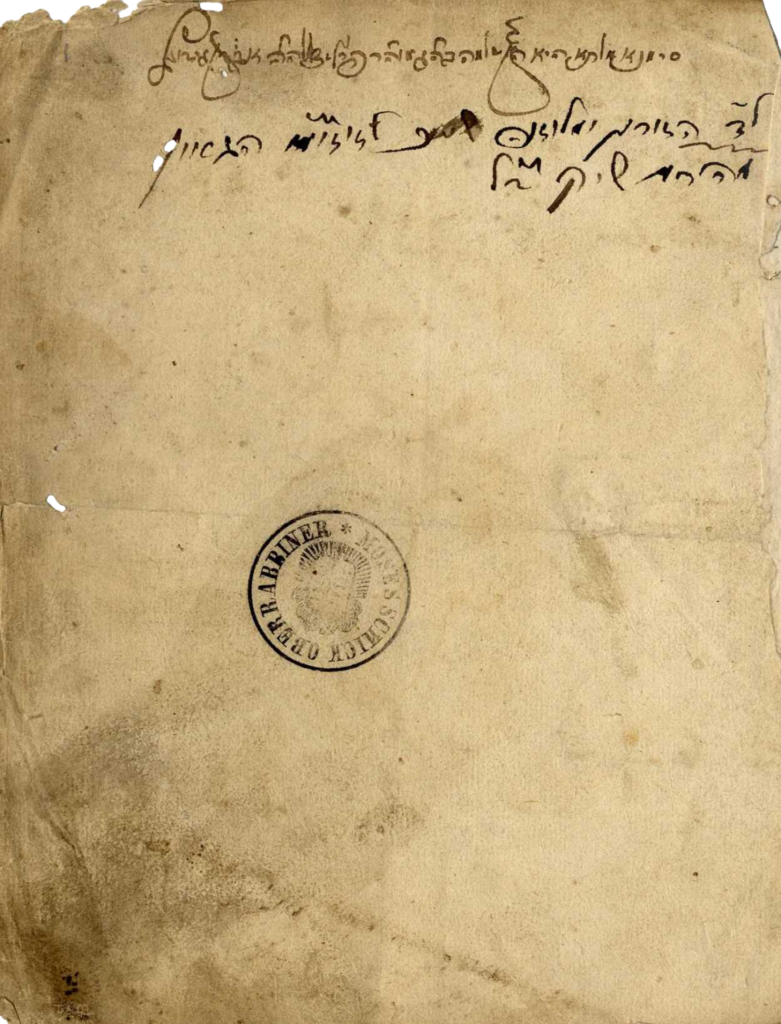
Unique handwritten kabbalistic work which is a completion for Meorei Ohr, called Meorot Natan, by Rabbi Meir Proops, which is a dictionary of kabbalistic concepts of the Ar”i’s kabbalah, arranged alphabetically (printed in Frankfurt 1709).
One of the basic works of kabbalah by Rabbi Meir Proops – one of the disciples of the Ar”i [מגורי האר י – lit. “of the lion’s cubs”], the Meorot Natan , which contains an index of alphabetically arranged kabbalistic entries. Two kabbalists came after him – Rabbi Natan Nota Manheim and Rabbi Akiva of Vilna, who arranged a work of references and foundations preliminary to Rabbi Meir, and they called their work Yair Nativ . Rabbi Shlomo Av Beit Din of Gading came and added thousands of references from kabblistic books to complete their work. Not only that, he added many sweet explanations to the secrets of the Torah; this is the work before us.
Thick manuscript of kabbalistic entries by the gaon, kabbalist Rabbi Shlomo son of Peretz, Av Beit Din of Gading. His father is Peretz son of Shlomo Frenkel, Av Beit Din of Gading, Marne, a descendant of Rabbeinu Peretz MiBa’alei HaTosafot.
Rabbi Peretz passed away in 1773, and the next year Jews were expelled from Gading by order of the wicked Queen Maria Theresa; and they did not return until 1788 by permission from her son Joseph II. His son, the gaon kabbalist Rabbi Shlomo, also a resident of Gading, who apparently succeeded his father, predicted the expulsion, as told by the Mahara”m Schick’s ritual slaughterer. Mrs. Rivkah, wife of Rabbi Yosef Schick – father of the Mahara”m Schick, was a granddaughter of the gaon Rabbi Peretz Frenkel. Many writings remain, from both father and son. A wondrous fact told by the Mahara”m Shick regarding Rabbi Shlomo: One morning, when he woke up, he rushed to awaken everyone in his home, and he told them that it was revealed to him from Heaven that a decree has been decreed on the city, and they must flee to Hungary immediately. After morning prayers, he urged the townspeople to flee, and added: As local rabbi, he would not leave the city until the last Jew has left. But the locals delayed leaving, and rioters entered and killed everyone, with the rabbi at their head.
At the top: (leaf 25a): “References here that are to be added to the book Yair Nativ which was composed on Meorei Ohr .” Owner’s signature on leaf 1a: “The small one, Shlomo son of the gaon our teacher Rabbi Peretz, zlh”h, Av Beit Din […?], “Belongs to our father, our teacher, the gaon Mahara”m[she] z”l” and the stamp: Oberrabbiner Moses Schick.
Rabbi Moshe Schick [1807-1879], the Mahara”m Schick, was the primary disciple of the Chatam Sofer, well-known rabbi of Chust and its rosh yeshivah, one of the great adjudicators of Hungary and leader of believing Jewry in Hungary. He wrote novellae on Shas, a series of books of responsa, sermons, and more.
210 leaves, paper. 18×14 cm. Pleasant, orderly Ashkenazic script.
Fine condition. Stains, original leather binding.
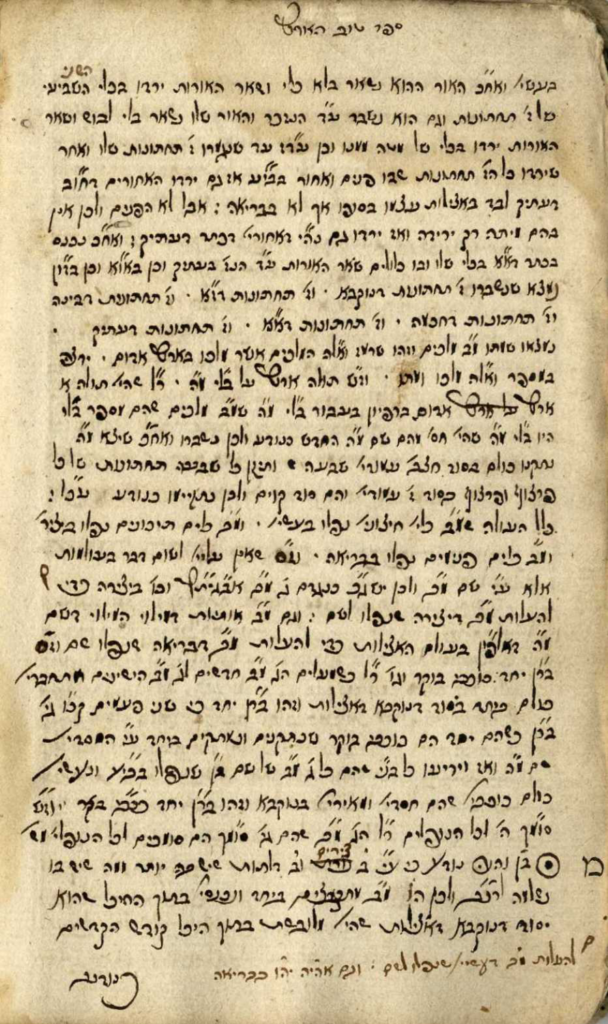
Handwritten copy of the kabbalistic work Tuv Haaretz by kabbalist Rabbi Natan son of Reuven David Tevel Shapira. In his introduction, the author writes that his words are based on the Ari’s kabbalah and that of his disciple Rabbi Chaim Vital. He also based his words on the Torah of Rabbi Moshe Cordovero and of Rabbi Avraham Azoulay. 18th century.
About [140] pages, ink on paper. 16.5×10. Missing the beginning and end. Ashkenazic hand with erasures, corrections and marginal notes in a number of places. Accompanied by [2] leaves, paper, in a different hand, from the Megaleh Amukot by Natan Nota son of Shlomo Shapiro.
The author, Rabbi Natan Shapiro of Jerusalem (also known by the title given to him by the Chid”a – “HaRav HaNasi” an abbreviation of his name הרב נ תן ש פירא י שמרהו א -לוהים), was a erudite kabbalist and emissary. He was sent by the Ashkenazic community in Jerusalem to Italy, Holland and Germany. It is related that he received a “Heter Meah Rabbanim” in Jerusalem to marry two wives, and he lived with both of them in Jerusalem. When he was in Venice in 1665, he published his Tuv Ha’aretz , a kabbalistic work whose first section discusses the virtues of the Land of Israel; the second section explains the mishnah about the 10 sanctities in tractate Keilim (1,6) in a kabbalisitc manner; and the third section explains Tikkun Chatzot. He passed away in Italy in [1667].
Moderate-fine condition. Partially dismantled spine, some detached leaves, stains, tears with loss in a number of leaves, minimal worming holes. Without binding.
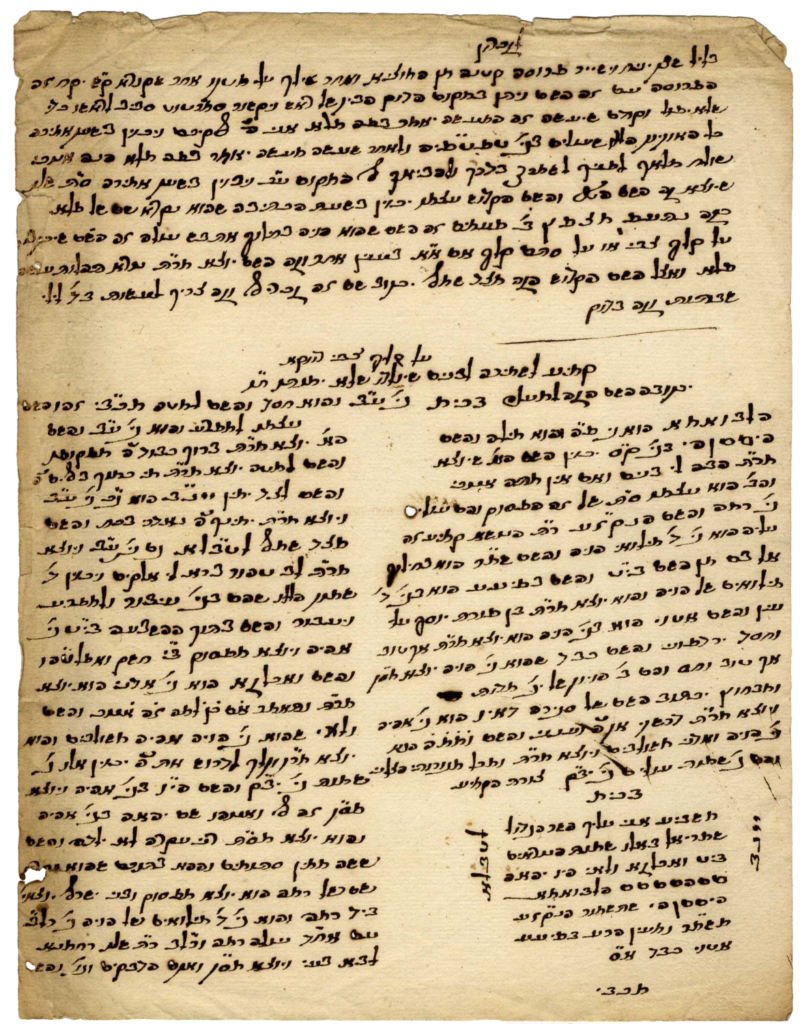
Amulet to protect children from dying – handwritten by the great Rabbi Shlomo Michael Yonah, Av Beit Din of Turin. 18th century.
Amulet text to protect ‘children who were born, that they not die, Heaven forbid’ with holy Names, oaths and instructions how it is to be written, handwritten by the great Rabbi Shlomo Michael Yonah, Av Beit Din of Turin, one of the greatest Italian sages of his generation.
At the beginning of the amulet, Rabbi Shlomo Michael indicates that it is to be written ‘specifically on deer parchment.’ In the right margins, he indicates ‘the form of the amulet.’ An additional segulah, for memory, is noted at the top of the leaf.
T he gaon Rabbi Shlomo Michael Yonah was the Av Beit Din of Turin. He was one of the greatest rabbis in Italy in his time – ‘מתקיפי דארעא’ [‘among the sharpest in the land’] in the words of Rabbi Menachem Ezra Meir Kastelonovo in his responsa, Emek HaMelech (21b). A native of Alessandria della Palia, Italy, where he studied Torah with the great sage, expert in both the revealed and hidden [aspects of Torah], Rabbi Eliyahu HaLevi. When the Chid”a arrived on his way to his mission in Alessandria, he became very close with Rabbi Shlomo Michael. In his letters, the Chid”a would praise him extensively. The Chid”a testified that he behaved piously, and out of his great affection for him he called him ‘the apple of my right eye’ ( Iggerot V’Haskamot HaChid”a , Vaknin, page 56). There is a letter of admiration from him to the Chid”a, printed in the Moriah collection, year 18, issue 205-206, Tishrei, 1991, page 64. He apparently also studied kabbalah with his teacher, Rabbi Eliyahu HaLevi.
His responsa regarding the controversy that arose in Italy with respect to whether to recite hymns on the night of Shemini Atzeret which fell on Shabbat, before Mizmor Shir L’Yom HaShabbat , was agreed upon by his teacher as well as Rabbi Yishmael HaCohen, Av Beit Din of Modena, author of Zera Emet . Refer to: Kovetz Etz Chaim (Sanz) issue 5 2003, page 3.
[1] leaf. Ink on paper. 25×19 cm. Fine condition. Two tiny perforations due to the acidity of the ink, slight wear in the corners.
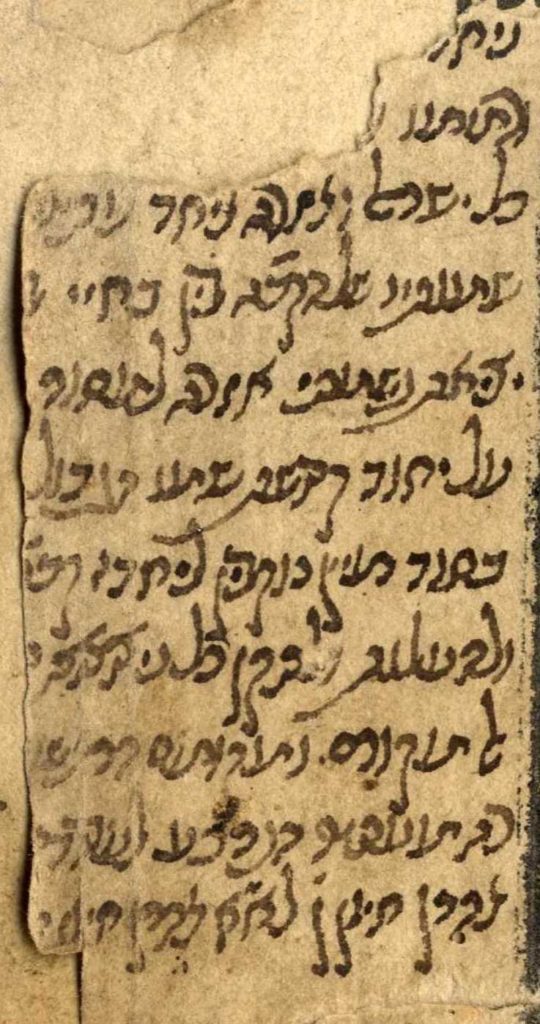
Hundreds of long exegeses, glosses and corrections on Zohar , Mantua print, written by the G-dly kabbalist Rabbi Aharon Chayun, author of Machaneh Aharon . Many of the text and version corrections were not printed in Machaneh Aharon .
At the beginning of the work, on leaf 1a, there is a fascinating notation in Rabbi Aharon Chayun’s handwriting, which reveals to us the world of the wondrous kabbalist which wished to die a martyr’s death, as he writes, inter alia: ‘… and may I merit to unify the Names of the Holy One, Blessed be He, whether in life, or as my soul departs, may I submit it with the unification of the sanctification of His Great Name … to ascend and rectify all the sparks … to their sources and original places, so petitions the subjugated to the service … Aharon Chayun …”
This exact copy came into the hands of the complete sage, Rabbi Yitzchak Avzamil of Egypt. He copied it and added his own glosses. Later, the book Machaneh Aharon was printed in Livorno in 1795.
In this copy, there are also glosses handwritten by Rabbi Yitzchak Avzamil, eventually printed in his name in the Machaneh Aharon mentioned above, with the abbreviation יא”י (see, for example, leaf 18a).
Rabbi Yitzchak copied the commentaries, however, not the thousands of text corrections arranged by Rabbi Aharon, so that before us there is a Zohar on Bereishit and Hakdamat HaZohar , proofread and corrected in the handwriting of the great kabbalist Rabbi Aharon Chayun, author of Machaneh Aharon.
As such, there are glosses by additional kabbalists in different scripts, some were printed in Machaneh Aharon without attribution, not in Rabbi Aharon’s name [see, for example, leaf 149a] and there are apparently some glosses authored by a different writer, mistakenly attributed to Rabbi Aharon [see, for example, on leaves 53b, 73a].
The kabbalist Rabbi Ovadiah Aharon Chayun was among the greatest sages of Jerusalem in the 17th century, a contemporary of the author of Pri Chadash and the Mahara”m Galanti – and one of the members of his Beit Din. Some of his responsa are quoted in the works of the sages of his generation, Shu”t Zera Avraham , Shu”t Darkei Noam , Shu”t Mateh Yosef [refer to the Chid”a’s Midbar Kdemut , chapter 50, section 13]. He is a signatory along with the sages of Jerusalem of 1747 on an approbation for Shu”t Shaar Ephraim . His son was Moshe Chayun, Av Beit Din of Safed.
There is a terrible event brought in Toldot Chachmei Tunis set 8: Once, the rosh yeshivah, Rabbi Aharon Chayun, who was quite elderly, did not arrive. His son, Rabbi Moshe Chayun, sat in his place. The sages conspired to test the extent of the author of Pri Chadash’ s knowledge of the revealed and hidden [aspects of Torah], and when the author of Pri Chadash understood their intent, a tremendous quarrel ensued, until morning’s light. When Rabbi Aharon heard of this, he cried a great, bitter cry and said that a decree has already been decreed that none of them would live out the year. And so it was, even the author of Pri Chadash passed away that year, at 36 years old.
From the title “Chassid” given to him by the Jerusalem sages, the Chid”a and the Mahara”m Meyuchas, one can learn of his greatness in kabbalah, as this title was reserved for only the greatest of kabbalists, (see the ‘Machaneh Aharon’ entry in Shem Gedolim and Mahara”m Galanti and in Brechot Mayim 43a, where the Mahara”m Meyuchas relates that he heard from his father, author of Pri HaAdamah , that Rabbi Aharon Chayun was the chazzan who passed in front of the holy ark when there was a drought in Jerusalem).
Zohar Bereishit , Mantua 1558 242 leaves, lacking [8] leaves at the beginning of the book, leaves 81-87 and leaves 243-251 at its end. 20 cm. Poor condition. With worming holes, dampstains, a small part of the written glosses are blurred due to water damage. Dismantled binding, in a matching new cardboard box.
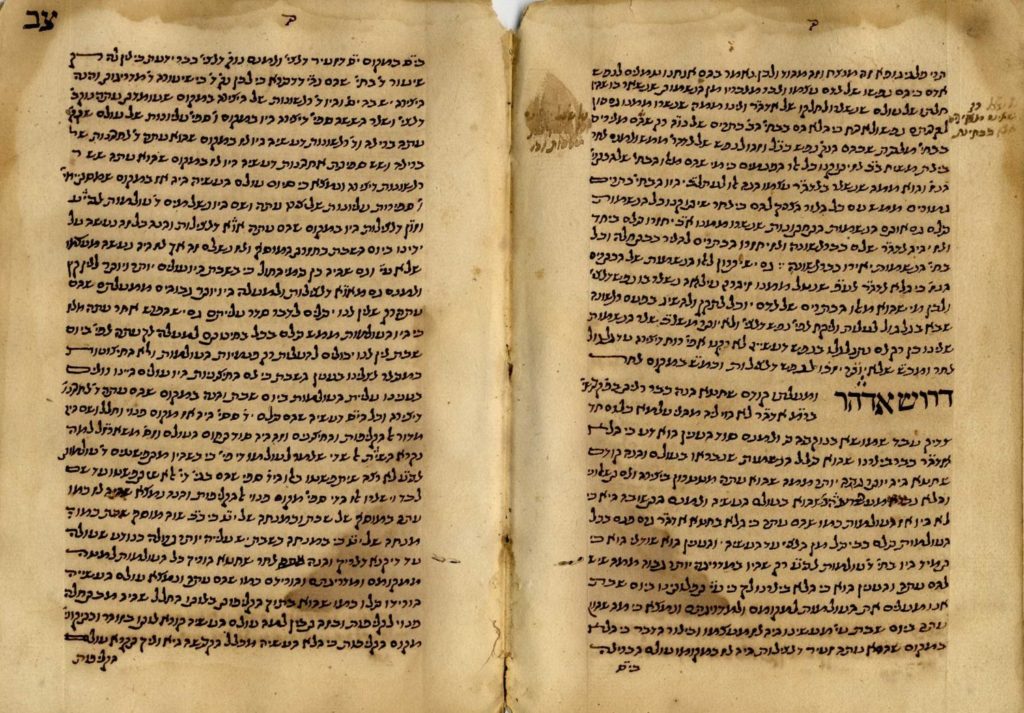
Handwritten copy of Adam Yashar ; renewed sermons, summaries and conclusions from the Ari z”l’s thought, authored by Rabbi Chaim Vital. North Africa, 18th century. Incomplete.
[54] pages. Ink on paper. 16X23 cm. Elegant and orderly Maghrebi script. This manuscript lacks the beginning; it starts in the middle of a topic which is left unfinished until the end (sermon on Z e’er Anpin appears fully), and concludes with two notes by R’ Tzemach.
Moderate-fine condition. Reinforced on first and last page. Aging stains. New binding.
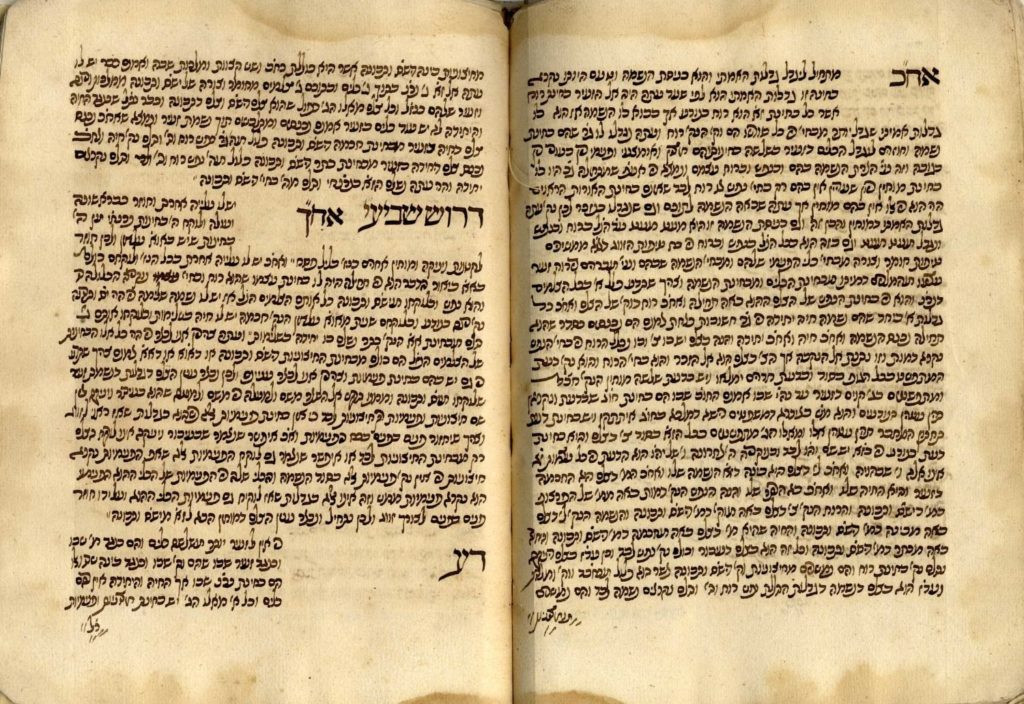
Thick handwritten manuscript containing a collection of sermons on the Ari’s kabbalah from various locations. Morocco, 18th century. Incomplete .
About 270 pages. Ink on paper. 14×20 cm. Condensed and orderly Moroccan script. Dozens of glosses on leaf margins. Leaf 129a bears a note signed: “The young Yosef Elmani.”
Moderate-fine condition. Aging stains. Approx. ten worn and torn pages with lack. Few ink smears. The remaining leaves are in fine condition. Not bound.
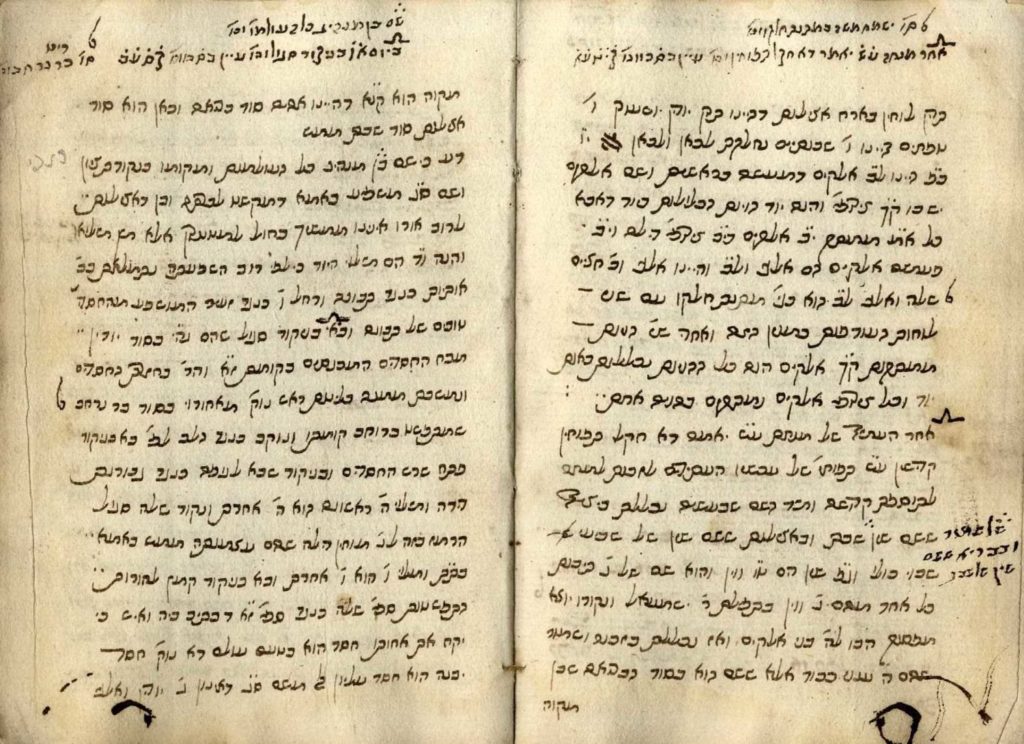
Manuscript compiling the Ari z”l’s Tikkunei Avonot and Kavanot HaTefillah. 18th century. Incomplete.
142 pages. Ink on paper. 11×16 cm. Numbered from 183-256, missing beginning and end. Sephardic hand by two different scribes.
Most of the compilations are from Sha’ar Ruach HaKodesh and Sha’ar HaKavanot . Includes numerous glosses and comments on the leaf margins.
Fine condition. Aging stains. Few worming holes. Unbound.
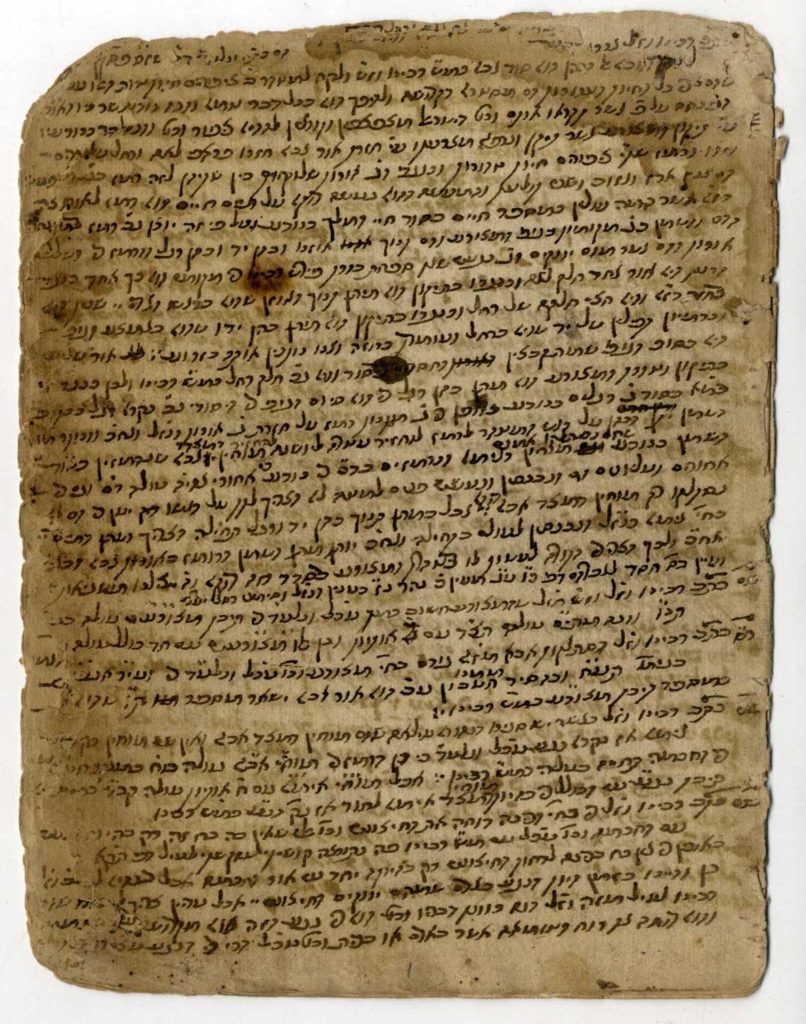
Excerpt from the book Diglei Ahavah V’Re’ach Sadeh, by Rabbi Avraham son of Shmuel Meyuchas, author of Sadeh Ha’aretz . Includes notes on Etz Chaim by Rabbi Chaim Vital. 18th century.
Rabbi Avraham son of Rabbi Shmuel Meyuchas [c. 1727 -1767] was among the rabbis of Jerusalem, and authored Sadeh Ha’aretz; responsa and sermons. Refer to: Mechkarei Sefer [Jerusalem, 1958], pages 138-139.
[6] leaves, paper. Written on both sides of the leaf. Sephardic script. 20×16 cm. The manuscript begins with ” Sha’ar l”ch Leah V’Rachel ,” including corrections and erasures, appears to be an autograph. These excerpts were not included in the printed edition (Jerusalem, Ahavat Shalom , 2003).
Moderate condition. The first page margins and leaves’ corners are worn. Tear with lack on the outer top of the last page. Stains. Holes where the leaves were previously bound.
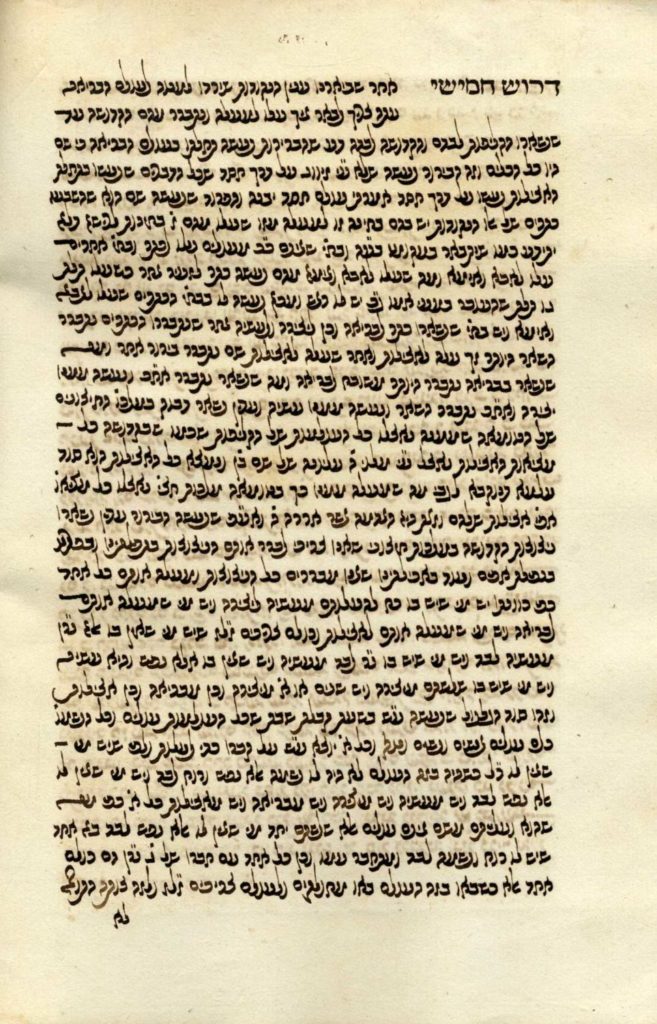
Handwritten manuscript of Sefer HaDrushim by Rabbi Yosef ibn Tabul. Contains quotations from Etz Chaim. At the book’s end the author describes how he was saved from sorcery, and summarizes Rabbi Yisrael Saruk’s composition. The 18th century.
17, 19-33, [2]. Due to an error in page numbering, page 18 is not numbered. Contains numerous glosses on the leaves’ sides and at the manuscript’s end. Tunisian script. 17×25 cm. The final annotation ends with the hope that “I will merit to return to the city of Tiberias … Aharon Meir Moyal.”
Rabbi Yosef Maaravi , known as ibn Tabul, was a disciple of the Ari’s. His sermon, “Cheftzi Bah,” was published in the book Simchat Cohen [Jerusalem, 1921] by Rabbi Massoud HaCohen Chadad [the sermon was mistakenly attributed there to Rabbi Chaim Vital].
Rabbi Yisrael Saruk [Sarug] (approx.1540-1610), immigrated to Israel between the years 1565-1571, where he compiled the Ari’s writings. He journeyed in Europe, Turkey, and Egypt, where he disseminated the Ari’s kabbalah. He influenced the writings of Ashkenazi kabbalists, and was rabbi to Menachem Azaria from Pano, Italy.
Condition: Fine. Aging stains. New binding.

Composition on practical kabbalah. Contains segulot, amulets, zodiac signs, charts, tables, letters and names in practical kabbalah. Amulets for healing, marital harmony, one who has distanced himself from home, and more. Most are in Arabic, with a few in Hebrew. Yemen, 18th-19th century.
About 100 pages. Ink on paper. Elegant Yemenite script.
Fine condition. Stains. Tear on side of one leaf. New binding.